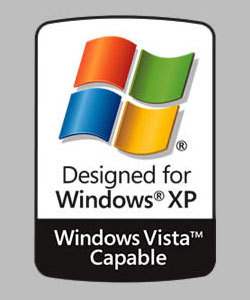Microsoft Told "Vista Home Basic" Isn't Vista
While many PC enthusiasts are eagerly awaiting the arrival of Windows 7 so they can ditch Vista and XP, Microsoft is still wrestling with issues from the launch of its last operating system.
The company is still under legal scrutiny as it battles a class-action lawsuit surrounding its “Windows Vista Capable” branding that it placed on new PCs sold with Windows XP. The idea behind the label was that consumers could be confident in purchasing a new PC before the launch of Vista and not be worried that his or her computer wouldn’t be able to run the upcoming operating system.
Problems came when Vista launched and owners of supposed “Vista Capable” machines suddenly found themselves able to run the new OS at a bare minimum, but without the immediately apparent new coat of UI shine called “Aero Glass.” This upset customers who felt that they were mislead into thinking that even their budget computers could run the best of what Vista had to offer, when really Vista Home Basic (without all the UI bells and whistles) would be as good as it would get.
On the surface, one might assume that Microsoft ran into some bad luck and gave the customer too much credit when it came to realistic expectations, but documents unsealed in the ongoing legal process show that the company was forewarned about the use of the Vista brand on the Home Basic edition.
While Home Basic was Vista at its core, it’s something that the consumer might not easily see. For that reason, the Windows Product Management Group recommended in August 2005 that Home Basic should "carry the Windows brand name without the Vista generation name," reported the Seattle P-I.
The Group continued that having Home Basic sans the Vista brand would "better align user product expectations to the high visibility innovations uniquely present in the Windows Vista premium versions." This could have potentially saved Microsoft from the class-action lawsuit it presently faces, but would have completely changed the “Vista Capable” requirements.
Microsoft did provide a good argument in its white paper declaration (PDF hosted on the P-I) for why Home Basic should be called Vista, which seems to also make sense since it is just a low-end variant of Vista: "The White Paper gives a more balanced assessment than Plaintiffs portray. It expressed concern that removing the Windows Vista name from Windows Vista Home Basic could create 'customer confusion' because customers might think 'a new PC with Home Basic did not come with the latest [operating system]' when in fact it did.”
Get Tom's Hardware's best news and in-depth reviews, straight to your inbox.
It’ll be interesting to see how Microsoft will change its strategy for the sales transition from Vista to Windows 7.
-
tayb So is Windows XP Home Edition not really XP because it doesn't have the extra features that Windows XP Pro Edition does??? WOW. Someone please take control of all these lawsuits. People are making a living doing nothing but suing other people.Reply -
runmymouth Windows Media is the xp version of home premium. Home basic.... sounds just like what it is. The basic version of windows to run stuff.Reply -
Shadow of Dawn WOW some people are so stupid, if your computer cant run vista use XP or get a NEW one.....IDIOTS!!!!!!!!Reply -
rodney_ws I realize I have a tech background and that Microsoft wasn't exactly clear on everything, but even from the perspective of an average consumer, I didn't feel that they were being dishonest. People who took the time to do their research would have known if their computers were ready for Vista Home Basic or some of the higher-tiered products. Microsoft makes the products... you choose to buy them or not. It really is that simple. Caveat emptor!Reply -
kamkal taybSo is Windows XP Home Edition not really XP because it doesn't have the extra features that Windows XP Pro Edition does??? WOW. Someone please take control of all these lawsuits. People are making a living doing nothing but suing other people.Reply
+1
yea i mean itz called "VISTA BASIC" for a reason lol
-
kamkal and why would anyone want to leave aero glass on to begin with?Reply
just slows down the interface; i mean not even from a hardware perspective but the fact that the animations in windows take time to play and dont add to anything
i mean they look cool for like 10 minutes then they just get annoying lol -
pbrigido rodney_wsI realize I have a tech background and that Microsoft wasn't exactly clear on everything, but even from the perspective of an average consumer, I didn't feel that they were being dishonest. People who took the time to do their research would have known if their computers were ready for Vista Home Basic or some of the higher-tiered products. Microsoft makes the products... you choose to buy them or not. It really is that simple. Caveat emptor!Reply
Right on Rodney.
I am coming to believe that Vista was released as a necessary growing pain in order to promote a new and better OS than XP, mainly Windows 7. Although I do run Vista 64 bit and love it, I can easily understand how the average consumer (the ones who would never have an interest coming to THG) could find Vista to be nothing more than a pain the the butt.
In my experience, Windows 7 is an awsome OS so far, however, we would not come to appreciate its success without the introduction Vista.
-
rodney_ws pbrigidoRight on Rodney.I am coming to believe that Vista was released as a necessary growing pain in order to promote a new and better OS than XP, mainly Windows 7. Although I do run Vista 64 bit and love it, I can easily understand how the average consumer (the ones who would never have an interest coming to THG) could find Vista to be nothing more than a pain the the butt. In my experience, Windows 7 is an awsome OS so far, however, we would not come to appreciate its success without the introduction Vista.Reply
Of course Windows 7 is going to be a smoother transition... it is essentially Vista SE. The teething problems with the drivers (new driver model) won't be an issue this time around... and now with memory being so cheap, 4-8 GB systems will be the norm so the even if Windows 7 has the same memory footprint, performance will be dramatically improved. If you give 'em enough time, Microsoft will usually get it right. It just stinks for those of us with Vista who actually had these problems.
In full disclosure, my Vista Home Premium 64 bit SP1 installation has worked flawlessly for me... absolutely flawless.
-
mdillenbeck Just to represent the other side...Reply
I think when the average customer hears "Vista Capable" they assume that it is capable of running Windows Vista. What do they know of Vista Home Basic, Vista Home Premium, Vista Business, and Vista Ultimate - the machine says Vista and nothing more.
Now, had they been branded "Vista Home Basic Capable", then customers would have had a clear picture that their was only one product with Vista in the title that would run on the machine.
THAT is why customers are feeling deceived.
I mean, if you bought a vehicle labeled "off road capable" and learned it could only drive off road on dry dirt paths with no greater than a 15 degree incline, you'd be pretty pissed off when you try to slug through some mud.
Finally, when calling all these people idiots, remember the Dilbert Principle - once we realize that we all have times when we are incredibly brain dead and stupid, then maybe we can learn to sympathize with others rather than condemn them.

